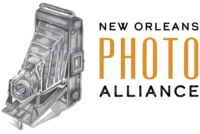You were just awarded the Michael P. Smith Grant for Documentary Photography…what were you thinking when NOPA announced your name?
I thought about so many people in this room around me and their fantastic work and how I look up to them and what a bizarre circumstance it was to be chosen among some of these heroes of mine. Then I thought that this level of validation for my work is nothing I have felt before and it feels great.
What made you begin the New Orleans portrait project?
It began rather unconsciously; a general interest in people which eventually made most sense (photographically) in the casual environs of their New Orleans worlds.
What did you learn during the process of creating your recently published book, “Jonathan Traviesa: Portraits in New Orleans 1998-2009”?
I learned that finishing anything that is a whole or complete – like a book – involves many unforeseen details. Also, I learned that once a project becomes goal-oriented – again, like this book – the momentum is very sustaining. Those details were many and varied, but easily overcome because of the focus related to the goal.
Now that you have received the MPS Grant, what are your plans?
I plan to follow through on my proposal which is to expand this project by photographing a wider range of subjects – specifically those that, in my opinion, are rather new to New Orleans and reshaping the direction of the city.
How did you first become involved in photography?
I took a photography class at Eckerd College, FL in 1996. Even though I cringe at much of my earliest work from then, it was one of the most exciting times of my life.
Your photography work includes sculptural influences and you also create sculptural installations….how do you see these two arenas intersect?
I like looking at the world as if it’s a giant sculptural installation – or at least, a great series of smaller installations. The more ambiguous an object is (or can be in a photograph) – the more I am drawn to it. I suppose that experiencing this draw becomes a tiny existential moment in my life. It is a pleasure to dwell in the question of some thing’s “is-ness” – especially with a camera.
It is true that I have occasional forays into installation work. This interest started directly in late 2005 after the New Orleans flood stuff. Creatively, I felt that the severity of the situation could not be fully handled with a camera. Actual, physical, three dimensional works or interventions into the landscape connected me to and vitalized me around this profound, tragic event and to the city as an artist more than 2-D representations.
Even though a couple of my photographs from the flood became rather well-known, I still think that they are only part of a gigantic pool of (eventually numbing) disaster images created in this curious, often dark world.
Do you have a photographic hero or anyone who inspires you?
Right now, I really appreciate Friedlander for the complexity of his images, his wide ranging interest, and his sheer commitment to the medium. In general though, there are too many to hone down in a definitive list, but Winograd, Arbus, Edgerton and Frank are up there.
The Ogden Museum of Southern Art
is currently exhibiting images from Traviesa’s book, through January 24.
www.ogdenmuseum.org




